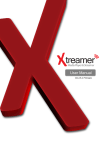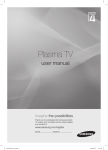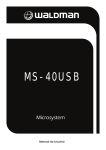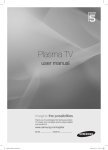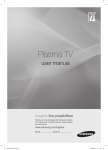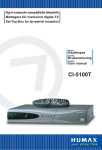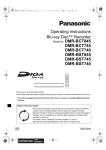Download Samsung FHD Flat TV Series 5 (32" J5100) User Manual
Transcript
Contents
Channel Setting
Advanced Features
• Using the INFO button
1
• Connecting a USB Device
68
• Memorizing channels
2
• Using the Media Play
74
• Using the Channel menu
5
• Playing the Photos / Videos / Music / Story Replay
77
• Locking Programme
17
• Using the Sports Mode
85
• Other Features
18
• Using the Family TV Mode function
86
• Viewing the e-Manual
91
• Using the Self Diagnosis
92
• Updating the Software
94
Basic Features
• Changing the Preset Picture Mode
25
• Changing the Use Mode
97
• Adjusting Picture Settings
26
• Viewing the Contact Samsung
98
• Changing the Picture Options
32
• Changing the Preset Sound Mode
41
• Adjusting Sound Settings
42
• Executing initial setup
50
Preference Features
• Setting the Time
51
• Using the Sleep Timer
53
• Setting the On / Off Timer
54
• Economical Solutions
59
• Other Features
61
• Using the Source List
67
Other Information
• Anti-theft Kensington Lock
99
❑❑ Using the INFO button
The TV identifies the current channel and the status of certain audio-video
settings.
NN When you press the INFO button, a channel information banner will appear
on the top of the screen. And then press the E button, you can see the
details of the programme. (digital channels only)
●● Scroll ◄, ► to view information for a desired programme while watching the
current channel.
●● Scroll ▲, ▼ to view information for other channels. If you want to move to the
currently selected channel, press the E button.
▶
❑❑ Memorizing channels
■■ Aerial (Terrestrial/Cable)
OO MENU → Broadcasting → Aerial → E
Before your television can begin memorising the available channels, you must
specify the type of signal source that is connected to the TV.
◀
▶
■■ Auto Tuning
OO MENU → Broadcasting → Auto Tuning → E
Scans for a channel automatically and stores in the TV.
NN Automatically allocated programme numbers may not correspond to actual
or desired programme numbers. If a channel is locked, the PIN input window
appears.
●● Auto Tuning
Aerial (Terrestrial/Cable): Select the aerial source to memorise.
◀
When selecting Terrestrial:
Digital & Analogue (Digital & Analogue / Digital / Analogue): Select the
channel source to memorise.
▶
When selecting Cable:
It scans for a channel automatically and stores in the TV.
◀
▶
❑❑ Using the Channel menu
OO MENU → Broadcasting → Channel List → E
■■ Channel List
◀
The Channel List contains the channels your TV displays when you press the
channel button. You can view channel information, All, TV, Radio, Data/Other,
Analogue or Favourites 1-5.
Press ►(Mode) button to change the channel mode, or press ◄ (Sorting) button
to change the channel order according to channel number or name on the list.
NN When you press the CH LIST button on the remote control, Channel List
screen will be displayed at once.
Channel Sorting
●● Number / Name: Arranges the channel order according to channel number or
name on the list.
▶
Channel Mode
●● Aerial: Switches to Terrestrial or Cable.
●● Edit Favourites: Set channels you watch frequently as favourites.
NN For detailed information about using Edit Favourites, refer to “Edit
Favourites”.
●● Favourites 1-5: Shows all favourite channels, arranged in up to five groups.
◀
Each group has a separate screen.
NN The TV displays Favourites 1-5 only if you have added favourites using
Edit Favourites.
●●
●●
●●
●●
All: Shows all currently available channels.
TV: Shows all currently available TV channels.
Radio: Shows all currently radio channels.
Data/Other: Shows all currently available MHP (Multimedia Home Platform) or
other channels.
●● Analogue: Shows all currently available analogue channels.
▶
■■ Guide
OO MENU → Broadcasting → Guide → E
The EPG (Electronic Programme Guide) information is provided by broadcasters.
Using programme schedules provided by broadcasters, you can specify
programmes you want to watch in advance so that the channel automatically
changes to the selected programme channel at the specified time. Programme
entries may appear blank or out of date depending on a channel status.
◀
●● a Red (Quick Nav): Viewing the TV programmes on the list quickly using
▲/▼/◄/► buttons. (Only for digital TV)
●● b Green (Channel Category): Select the type of channels you want to
display.
●● { Yellow (Schedule Manager): Moves to the reserved programmes in
Schedule Manager.
▶
■■ Schedule Manager
OO MENU → Broadcasting → Schedule Manager → E
You can set a desired channel to be displayed automatically at the intended time.
In addition, you can view, modify or delete a channel you have reserved to watch.
NN You must set the current time first using the System → Time → Clock
function in the System menu to use this function.
◀
1. Select the Schedule on the Schedule Manager screen to use Schedule
Viewing.
2. Press the ▲/▼/◄/► buttons to set each option menu.
●● Aerial: Select the desired broadcasting signal.
●● Channel: Select the desired channel.
▶
●● Repeat: Select Once, Manual, Sat~Sun, Mon~Fri or Everyday to set at
your convenience. If you select Manual, you can set the day you want.
NN The (c) mark indicates the day you’ve selected.
●● Date: You can set the desired date.
NN It is available when you select Once in Repeat.
●● Start Time: You can set the start time you want.
NN If you want to edit or cancel a reserved schedule, select the reserved
◀
schedule on Schedule Manager. Then press the E button and select the
Edit or Delete.
▶
■■ Edit Channel
OO MENU → Broadcasting → Edit Channel → E
You can edit or delete channels.
1. Go to Edit Channel screen.
2. Press the ▲/▼ buttons to select the desired channel, then press the E
button. The (c) mark indicates the channel you’ve selected.
NN You can select more than one channel.
◀
NN Press the E again to deselect the channel.
▶
NN Using the coloured and function buttons with the Edit Channel.
●● a Red (Change Number): Changes channel order on the channel list.
●● b Green (Delete): Deletes a channel from the channel list.
●● { Yellow (Lock / Unlock): Lock a channel so that the channel cannot be
selected and viewed. / Unlock the channel that you locked.
NN This function is available only when the Channel Lock is set to On.
NN The PIN input screen appears. Enter your 4-digit PIN(The default
◀
pin is 0-0-0-0.). Change the PIN using the System → Change PIN
option.
▶
●● } Blue (Select All / Deselect All): Selects or deselects all channels at
once.
●● Ÿ (Go To): Goes to channel directly by pressing numbers (0~9) and the
E button.
●● k (Page): Moves to previous or next page.
●● T (Tools): Displays the option menu. The option menu items that appear
may differ depending on the channel status and type.
◀
▶
–– Sorting (only for digital channels ): Changes the list ordered by
channel number or channel name.
–– Category: Changes the channel mode to All, TV, Radio, Data/
Other, Analogue, Recently Viewed, Most Viewed. The selected
channel mode is displayed.
–– Edit Favourites: Goes to Edit Favourites Screen directly.
–– Rename channels (analogue channels only): Assign a name of
◀
up to five characters to a channel. For example, Food, Golf, etc.
This makes it easier to find and select the channel.
–– Channel Info: Display details of the selected channel.
–– Information: Display details of the selected programme.
▶
■■ Edit Favourites t
OO MENU → Broadcasting → Edit Favourites → E
You can add, edit or delete favourite channels.
1. Go to Edit Favourites screen.
2. Press the ▲/▼ buttons to select the desired channel, and then press E
button.
◀
3. Choose a specific favourite list among Favourites 1-5 using b (Change Fav.)
button, and then press the } (Add) button. The selected channel has been
added in Favourites 1-5.
NN One favourite channel can be added in several of favourites among
Favourites 1-5.
▶
NN Using the coloured and function buttons with the Edit Favourites.
●● a Red (Category)
–– Category: Changes the channel mode to All, TV, Radio,
Analogue, Data/Other, Recently Viewed, Most Viewed. The
selected channel mode is displayed.
–– Change order: Changes the favourite channel order.
●● b Green (Change Fav.): Changes favourite list among Favourites 1-5.
●● { Yellow (Select All / Deselect All): Selects or deselects all channels at
◀
once.
●● } Blue (Add / Delete)
–– Add : Adds selescted channels to Favourites 1-5.
–– Delete : Deletes the favoruite channel from Favourites 1-5.
●● Ÿ (Go To): Goes to channel directly by pressing numbers (0~9).
●● k (Page): Moves to previous or next page.
▶
●● T (Tools): Displays the option menu among Favourites1-5. The option
menu items that appear may differ depending on the channel status and
type.
–– Copy to Favourites: Edit the selected favourite channel in
Favourites 1-5. You can copy this channel to the other favourite
list.
–– Aerial: Selects the desired broadcasting signal.
–– Rename Favourites: Assign your own favourites name.
◀
–– Edit Channel: Goes to Edit Channel Screen directly.
–– Information: Displays details of the selected programme.
▶
❑❑ Locking Programme
■■ Channel Lock
OO MENU → Broadcasting → Channel Lock → E
Enter your 4-digit PIN,the default of which is "0-0-0-0".Change the PIN using the
Change PIN option.
Lock channels in Edit Channel menu to prevent unauthorized users, such as
children, from watching unsuitable programme.
◀
NN Available only when the Source is set to TV.
NN If set Channel Lock Off, it's necessary to input PIN again.
▶
❑❑ Other Features
■■ Channel Settings
OO MENU → Broadcasting → Channel Settings → E
●● Manual Tuning
Scans for a channel manually and stores in the TV.
◀
NN If a channel is locked, the PIN input window appears.
NN According to the channel source, Manual Tuning may be supported.
●● Digital Channel Tuning: Scans for a digital channel manually and stores
in the TV. Press the New button to search the digital channels. When
scanning has finished, a channel is updated in the channel list.
–– When selecting Aerial → Terrestrial: Channel, Frequency.
▶
●● Analogue Channel Tuning: Scans for an analogue channel. Press the
New button to search the channels by adjusting the Programme, Colour
System, Sound System, Channel, Search.
NN Channel mode
–– C (air channel mode) / S (cable channel mode): These two modes
allow you to select a channel by entering the assigned number
for each aerial broadcasting station or cable channel.
●● Fine Tune
◀
(analogue channels only)
If the signal is weak or distorted, fine tune the channel manually.
NN Fine tuned channels are marked with an asterisk “*”.
NN To reset the fine-tuning, select Reset.
●● Clear Scrambled Channel
depending on the country
Search for the scrambled channel and remove them.
▶
■■ Subtitle t
OO MENU → Broadcasting → Subtitle → E
Use this menu to set the Subtitle mode.
●● Subtitle: Switches subtitles on or off.
●● Subtitle Mode (Normal / Hearing Impaired): Sets the subtitle mode.
●● Subtitle Language: Sets the subtitle language.
NN If the programme you are watching does not support the Hearing
◀
Impaired function, Normal automatically activates even if the Hearing
Impaired mode is selected.
NN English is the default in cases where the selected language is unavailable
in the broadcast.
●● Primary Subtitle: Sets the primary subtitle.
●● Secondary Subtitle: Sets the secondary subtitle.
▶
■■ Audio Options
(digital channels only)
OO MENU → Broadcasting → Audio Options → E
●● Audio Language
Change the default value for audio languages.
Primary audio / Secondary audio: You can set the primary or secondary
audio.
◀
NN The available language may differ depending on the broadcast.
●● Audio Format
Change a desired audio format. The supported audio format may vary
depending on the broadcast programme.
▶
●● Audio Description
This function handles the Audio Stream for the AD (Audio Description) which
is sent along with the Main audio from the broadcaster.
Audio Description: Turn the audio description function on or off.
Volume: Adjust the audio description volume.
◀
▶
■■ Digital Text (Disable / Enable)
◀
(This function may not support depending on the region.)
If the programme broadcasts with digital text, this feature is enabled.
MHEG (Multimedia and Hypermedia Information Coding Experts Group): An
International standard for data encoding systems used in multimedia and
hypermedia. This is at a higher level than the MPEG system which includes
datalinking hypermedia such as still images, character service, animation, graphic
and video files as well as multimedia data. MHEG is user runtime interaction
technology and is being applied to various fields including VOD (Video-OnDemand), ITV (Interactive TV), EC (Electronic Commerce), tele-education,
teleconferencing, digital libraries and network games.
▶
■■ Guide Type
depending on the country
OO MENU → Broadcasting → Guide Type → E
Select to use either the built-in or downloaded guide.
●● Guide: Set the built-in guide to be displayed when the GUIDE button on the
remote control is pressed.
●● Auto: Set the TV to select the proper guide automatically when the GUIDE
button on the remote control is pressed.
◀
▶
❑❑ Changing the Preset Picture Mode
OO MENU → Picture → Picture Mode → E
■■ Picture Mode t
Select your preferred picture type.
◀
●● Dynamic: Suitable for a bright room.
●● Standard: Suitable for a normal environment.
●● Natural Not for LED 4100 model : Provides a display that is comfortable to the
eyes.
●● Movie: Suitable for watching movies in a dark room.
●● Entertain: Suitable for watching movies and games.
NN It is only available when connecting a PC.
●● Stadium: When you turn Sports Mode to On, Picture Mode is set to
Stadium automatically to configure the picture settings suitable to sports
events.
▶
❑❑ Adjusting Picture Settings
■■ Backlight / Contrast / Brightness / Sharpness / Colour / Tint (G/
R)
Your television has several setting options for picture quality control.
NN NOTE
●● In analogue TV, AV modes of the PAL system, the Tint (G/R) function is
◀
not available.
●● When connecting a PC, you can only make changes to Backlight,
Contrast, Brightness, Sharpness.
●● Settings can be adjusted and stored for each external device connected
to the TV.
●● Lowering picture brightness reduces power consumption.
▶
■■ Picture Size
OO MENU → Picture → Picture Size → E
Set the various picture options such as picture size and aspect ratio.
NN The available items may differ depending on the selected mode.
NN Depending on the input source, the picture size options may vary.
●● Picture Size t: Your cable box/satellite receiver may have its own set
◀
of screen sizes as well. However, we highly recommend you use 16:9 mode
most of the time.
Auto Wide: Automatically adjusts the picture size to the 16:9 aspect ratio.
16:9: Sets the picture to 16:9 wide mode.
Wide Zoom: Magnifies the picture size more than 4:3.
NN Adjusts the Position by using ▲, ▼ buttons.
▶
Zoom: Magnifies the 16:9 wide pictures vertically to fit the screen size.
NN Adjusts the Zoom or Position by using ▲, ▼ button.
4:3: Sets the picture to basic (4:3) mode.
NN Do not watch in 4:3 format for a long time. Traces of borders displayed
on the left, right and centre of the screen may cause image retention
(screen burn) which are not covered by the warranty.
Screen Fit: Displays the full image without any cut-off when HDMI (720p /
1080i / 1080p) or Component (1080i / 1080p) signals are inputted.
◀
Custom: Select the size and aspect ratio of the picture displayed on-screen.
●● Zoom/Position: Adjust the picture size and position. It is only available in
Zoom or Custom.
●● Position: Adjust the picture position. It is only available in Screen Fit or Wide
Zoom.
▶
NN NOTE
●● After selecting Screen Fit in HDMI (1080i / 1080p) or Component (1080i
/ 1080p) mode, you may need to centre the picture:
1. Select the Position, press the E button.
2. Press the ▲/▼/◄/► button to move the picture.
●● If you want to reset the position you adjusted, select Reset in the Zoom/
◀
Position or Position screen. The picture will be set to its default position.
●● If you use the Screen Fit function, 1 line may be cut at the top and
bottom.
▶
■■ PIP
OO MENU → Picture → PIP → E
You can watch the TV and one external video source simultaneously. For
example, if you have a cable box connected to the Cable connector, you can use
PIP to watch programs from the cable box and watch a movie from a Blu-ray
player attached to the HDMI connector. PIP does not function in the same mode.
NN NOTE
◀
●● If you turn the TV off while watching in PIP mode, the PIP window will
disappear.
●● You may notice that the picture in the PIP window becomes slightly
unnatural when you use the main screen to view a game or karaoke.
▶
●● PIP settings
Main picture
Sub picture
Component, HDMI1, HDMI2/DVI
TV
●● PIP: Activate or deactivate the PIP function.
●● Aerial: Select either Terrestrial or Cable as the input source for the
◀
●●
●●
●●
●●
sub-screen.
Channel: Select the channel for the sub-screen.
Size (õ / ã): Select a size for the sub-picture.
Position (ã / – / — / œ): Select a position for the sub-picture.
Sound Select (Main/Sub): You can choose the desired sound Main
/ Sub in PIP mode.
▶
❑❑ Changing the Picture Options
■■ Advanced Settings
OO MENU → Picture → Advanced Settings → E
(available in Standard / Movie mode)
You can adjust the detailed setting for the screen including colour and contrast.
NN When connecting a PC, you can only make changes to the White Balance
◀
and Gamma.
●● Dynamic Contrast (Off / Low / Medium / High): Adjust the screen contrast. ▶
●● Black Tone (Off / Dark / Darker / Darkest): Select the black level to adjust
the screen depth.
●● Flesh Tone: Emphasize pink flesh tone.
●● RGB Only Mode (Off / Red / Green / Blue): Displays the red, green and blue
colour for making fine adjustments to the hue and saturation.
●● Colour Space (Auto / Native): Adjust the range of colours available to create
the image.
Auto automatically adjusts the colour space depending on the input signal.
Native applies a range that is wider than the input signal.
●● White Balance: Adjust the colour temperature for a more natural picture.
◀
R-Offset / G-Offset / B-Offset: Adjust each colour’s (red, green, blue)
darkness.
R-Gain / G-Gain / B-Gain: Adjust each colour’s (red, green, blue) brightness.
Reset: Resets the White Balance to its default settings.
▶
●● Gamma: Adjust the primary colour intensity.
●● Motion Lighting: Reduce power consumption by brightness control adapted
motion.
NN Only available in Standard mode.
◀
▶
■■ Picture Options
OO MENU → Picture → Picture Options → E
NN When connecting a PC, you can only make changes to the Colour Tone.
●● Colour Tone
NN Warm1 or Warm2 will be deactivated when the picture mode is
◀
Dynamic.
NN Settings can be adjusted and stored for each external device connected
to an input on the TV.
▶
●● Digital Clean View: If the broadcast signal received by your TV is weak, you
can activate the Digital Clean View feature to reduce any static and ghosting
that may appear on the screen.
NN When the signal is weak, try other options until the best picture is
displayed. Choose one option among Off / Low / Medium / High / Auto
/ Auto Visualisation
●● MPEG Noise Filter: Reduces MPEG noise to provide improved picture
◀
quality.
NN Change its option to Off / Low / Medium / High / Auto in MPEG Noise
Filter.
▶
●● HDMI Black Level: Selects the black level on the screen to adjust the screen
depth.
NN Available only in HDMI mode (RGB signals).
●● Film Mode (Off / Auto1 / Auto2): Sets the TV to automatically sense and
process film signals from all sources and adjust the picture for optimum
quality.
NN Available in TV mode, AV, Component (480i / 1080i) and HDMI (1080i).
NN If the screen does not seem natural, change its option to Off / Auto1 /
◀
Auto2 in Film Mode.
▶
●● Analogue Clean View: Reduce diagonal noise in the picture, caused by the
crosstalk of signal.
●● LED Clear Motion: Removes drag from fast scenes with a lot of movement
to provide a clear picture.
NN It will be deactivated when the picture mode is set to Natural.
NN The screen may become slightly darker when you play LED Clear
Motion.
◀
▶
■■ Picture Off
OO MENU → Picture → Picture Off → E
The screen is turned off but the sound remains on. Press any button except the
volume button and power button to turn on the screen.
◀
▶
■■ Reset Picture
OO MENU → Picture → Reset Picture → E
Resets your current picture mode to its default settings.
◀
▶
❑❑ Changing the Preset Sound Mode
■■ Sound Mode
OO MENU → Sound → Sound Mode → E
◀
●●
●●
●●
●●
●●
Standard: Selects the normal sound mode.
Music: Emphasizes music over voices.
Movie: Provides the best sound for movies.
Clear Voice: Emphasizes voices over other sounds.
Amplify: Increase the intensity of high-frequency sound to allow a better
listening experience for the hearing impaired.
●● Stadium: Select Sports Mode first, and will auto enter Stadium mode.
NN If Speaker Select is set to External Speaker, Sound Mode is disabled.
▶
❑❑ Adjusting Sound Settings
■■ Sound Effect
(standard sound mode only)
OO MENU → Sound → Sound Effect → E
●● DTS TruSurround HD
◀
This function provides a virtual 5.1 channel surround sound experience
through a pair of speakers using HRTF (Head Related Transfer Function)
technology.
●● DTS TruDialog
This function allows you to increase the intensity of a voice over background
music or sound effects so that dialogue can be heard more clearly.
▶
●● Equaliser
Use Equaliser to customize sound setting for each speaker.
Balance: Adjusts the balance between the right and left speaker.
100Hz / 300Hz / 1kHz / 3kHz / 10kHz (Bandwidth Adjustment): Adjusts the
level of specific bandwidth frequencies.
Reset: Resets the equaliser to its default settings.
NN If Speaker Select is set to External Speaker, Sound Effect is disabled.
◀
▶
■■ Speaker Settings
OO MENU → Sound → Speaker Settings → E
●● Speaker Select t
This lets you choose which speakers the TV uses for audio output.
NN When Speaker Select is set to External Speaker, the volume and
MUTE buttons will not operate and the sound settings will be limited.
NN When Speaker Select is set to External Speaker.
◀
●● TV Speaker: Off, External Speaker: On
NN When Speaker Select is set to TV Speaker.
●● TV Speaker: On, External Speaker: Off
NN If there is no video signal, both speakers will be mute.
▶
●● Auto Volume
To equalize the volume level on each channel, set to Normal.
Night: This mode provides an improved sound experience compared to
Normal mode, making almost no noise. It is useful at night.
NN To use the volume control on the source device connected to the TV,
set Auto Volume to Off on the TV. Otherwise, a change to the volume
control of the source device may not be applied.
●● TV Installation Type
◀
Automatically optimise the sound based on the position of the TV.
▶
■■ Additional Settings
OO MENU → Sound → Additional Settings → E
●● DTV Audio Level
◀
: MPEG / HE-AAC This function allows
you to reduce the disparity of a voice signal (which is one of the signals
received during a digital TV broadcast) to a desired level.
NN According to the type of broadcast signal, MPEG / HE-AAC can be
adjusted between -10dB and 0dB.
NN To increase or decrease the volume, adjust between the range 0 and -10
respectively.
digital channels only
▶
●● Digital Audio Out: Digital Audio out is used to provide digital sound, reducing
interference going to speakers and various digital devices such as a DVD
player.
Audio Format: You can select the Digital Audio output format. The available
Digital Audio output format may differ depending on the input source.
NN By connecting to 5.1ch speakers in a Dolby Digital setup, maximize your
◀
interactive 3D sound experience.
Audio Delay: Correct audio-video sync programmes, when watching TV or
video, and when listening to digital audio output using an external device such
as an AV receiver (0ms ~ 250ms).
▶
●● Dolby Digital Comp (digital channel only): This function minimizes signal
disparity between a dolby digital signal and a voice signal (i.e. MPEG Audio,
HE-AAC, ATV Sound).
NN Select Line to obtain dynamic sound, and RF to reduce the difference
between loud and soft sounds at night time.
Line: Set the output level for signals greater or less than -31dB (reference) to
either -20dB or -31dB.
RF: Set the output level for signals greater or less than -20dB (reference) to
either -10dB or -20dB.
◀
▶
■■ Reset Sound
OO MENU → Sound → Reset Sound → E
Reset all sound settings to the factory defaults.
◀
▶
❑❑ Executing initial setup
■■ Setup
OO MENU → System → Setup → E
Configure the channels and languages when setting up the TV for the first time or
when resetting the unit.
◀
NN Execute the initial setup following instructions that the TV guides.
NN The default PIN is: 0000
▶
❑❑ Setting the Time
■■ Time
OO MENU → System → Time → E
The current time will appear every time you press the INFO button.
●● Clock: Setting the clock is for using various timer features of the TV.
NN If you disconnect the power cord, you have to set the clock again.
◀
Clock Mode: Set up the current time manually or automatically.
–– Auto: Set the current time automatically using the time from a digital
channel.
NN The aerial must be connected in order to set the time automatically.
▶
–– Manual: Set the current time manually.
NN Depending on the broadcast station and signal, the auto time set up may
not be correct. In this case, set the time manually.
Clock Set: Set the Date and Time.
NN Available only when Clock Set is set to Manual.
NN You can set the Date and Time directly by pressing the number buttons
on the remote control.
◀
▶
❑❑ Using the Sleep Timer
OO MENU → System → Time → Sleep Timer → E
●● Sleep Timer t: Automatically shuts off the TV after a preset period of
time. (30, 60, 90, 120, 150 and 180 minutes).
NN Use the ▲/▼ buttons to select a period of time, and then press the E
button. To cancel the Sleep Timer, select Off.
◀
▶
❑❑ Setting the On / Off Timer
OO MENU → System → Time → On Timer or Off Timer → E
●● On Timer: You can set up three separate On Timer configurations. (On Timer
◀
1, On Timer 2, On Timer 3)
Setup: Select Off, Once, Everyday, Mon~Fri, Mon~Sat, Sat~Sun or
Manual to set at your convenience. If you select Manual, you can set up the
day you want to activate the timer.
NN The c mark indicates the day you’ve selected.
Time: Set the hour and minute.
Volume: Set the desired volume level.
▶
Source: To select the source of the content that will play when the TV turns
on. You can:
–– Select TV and have the TV display a specific air or cable channel.
–– Select USB and have the TV play back photo or audio files from a USB
device.
–– Select a source on your TV (HDMI1, HDMI2/DVI, AV, Component, etc.)
◀
that you have connected a set-top box to, and have the TV display a
channel from the set-top box.
NN The USB device must be connected to your TV before you can select
USB.
▶
NN If you select a source other than TV or USB, you must:
●● Have a cable or satellite set-top box attached to that source.
●● Set the set-top box to the channel you want to watch when the TV
goes on.
●● Leave the set-top box turned on.
NN When you select a source other than TV the Aerial and Channel options
will disappear.
Aerial (when the Source is set to TV): Select Air or DTV Air, Cable.
◀
Channel (when the Source is set to TV): Select the desired channel.
▶
Music / Photo (when the Source is set to USB): Select a folder in the USB
device containing music or photo files to be played when the TV is turned on
automatically.
–– If there is no music file on the USB device or the folder containing a music
file is not selected, the timer function does not operate correctly.
–– When there is only one photo file in the USB device, the slide show will not
play.
◀
–– If a folder name is too long, the folder cannot be selected.
–– Each USB you use is assigned its own folder. When using more than one
of the same type of USB, make sure the folders assigned to each USB
have different names.
▶
–– It is recommended that you use a USB memory stick and a multi card
reader when using On Timer.
–– The On Timer function may not work with USB devices with a built-in
battery, MP3 players, or PMPs made by some manufacturers because
these devices take a long time to be recognized.
●● Off Timer: You can set up three separate Off Timer configurations. (Off Timer
◀
1, Off Timer 2, Off Timer 3)
Setup: Select Off, Once, Everyday, Mon~Fri, Mon~Sat, Sat~Sun or
Manual to set at your convenience. If you select Manual, you can set up the
day you want to activate the timer.
NN The c mark indicates the day you’ve selected.
Time: Set the hour and minute.
▶
❑❑ Economical Solutions
■■ Eco Solution
OO MENU → System → Eco Solution → E
●● Energy Saving (Off / Low / Medium / High): This adjusts the brightness of
◀
the TV in order to reduce power consumption.
●● Eco Sensor Not for LED 4100 model : To enhance your power savings, the picture
settings will automatically adapt to the light in the room.
If you adjust the Backlight the Eco Sensor will be set to Off.
Min. Backlight: When Eco Sensor is On, the minimum screen brightness
can be adjusted manually.
NN If Eco Sensor is On, the display brightness may change (become slightly
darker or brighter) depending on the surrounding light intensity.
▶
●● No Signal Power Off (Off / 15 min / 30 min / 60 min): To avoid unnecessary
energy consumption, set how long you want the TV to remain on if it’s not
receiving a signal.
NN Disabled when the PC is in power saving mode.
●● Auto Power Off (Off / On): If the Auto Power Off is On, the TV will be
automatically turned off when no user operation is received for 4 hours.
◀
▶
❑❑ Other Features
■■ Menu Language
OO MENU → System → Menu Language → E
Set the menu language.
◀
▶
■■ Change PIN
OO MENU → System → Change PIN → E
Change your password required to set up the TV.
NN The PIN input screen appears before the set up screen.
NN Enter your 4-digit PIN (The default Pin is 「0-0-0-0」). Change the PIN using
the Change PIN option.
◀
▶
■■ Auto Protection Time
OO MENU → System → Auto Protection Time → E
If the screen remains idle with a still image for a certain period of time defined by
the user, the screen saver is activated to prevent the formation of ghost images
on the screen.
◀
▶
■■ General
OO MENU → System → General → E
●● Game Mode: When connecting to a game console such as Play Station™ or
Xbox™, you can enjoy a more realistic gaming experience by selecting game
mode.
NN NOTE
◀
●● Precautions and limitations for game mode.
–– To disconnect the game console and connect another external
device, set Game Mode to Off in the setup menu.
–– If you display the TV menu in Game Mode, the screen shakes slightly.
▶
●● Game Mode is not available in TV mode.
●● After connecting the game console, set Game Mode to On.
Unfortunately, you may notice reduced picture quality.
●● If Game Mode is On:
–– Picture Mode is set to Game and Sound Mode is set to Game.
●● Panel Lock: Lock or unlock all the keys on the TV. When Panel lock is on,
none of the keys on the panel will work.
●● Boot Logo: Display Samsung logo when the TV is turned on.
◀
▶
■■ DivX® Video On Demand
OO MENU → System → DivX® Video On Demand → E
Shows the registration code authorized for the TV. If you connect to the DivX
web site and register with 10-digit registration code, you can download the VOD
activation file.
Once you play it using Videos, the registration is completed.
NN For more information on DivX® VOD, visit http://vod.divx.com.
◀
▶
❑❑ Using the Source List
■■ Source List
OO MENU → Applications → Source List → E
NN When you press the SOURCEs button, Source screen will be displayed at
once.
NN You can only choose external devices that are connected to the TV. In
◀
Source, connected inputs are highlighted.
▶
❑❑ Connecting a USB Device
1. Turn on your TV.
2. Connect a USB device containing photo, music and movie files to the USB
port on the side of the TV.
3. When USB is connected to the TV, popup window appears. You can select
the Photos, Videos, Music, or Story Replay directly.
◀
▶
NN It might not work properly with unlicenced multimedia files.
NN Need-to-Know List before using Media Play.
●● MTP (Media Transfer Protocol) is not supported.
●● The file system supports NTFS (Read Only), FAT16 and FAT32.
●● Certain types of USB Digital camera and audio devices may not be
◀
compatible with this TV.
●● Media Play only supports sequential jpeg format.
●● Media Play only supports USB Mass Storage Class (MSC) devices. MSC
is a Mass Storage Class Bulk-Only Transport device. Examples of MSC
are Thumb drives, Flash Card Readers (USB HUB are not supported).
Devices should be connected directly to the TV’s USB port.
▶
●● Before connecting your device to the TV, please back up your files to
●●
●●
●●
●●
◀
●●
prevent them from damage or loss of data. SAMSUNG is not responsible
for any data file damage or data loss.
Do not disconnect the USB device while it is loading.
The higher the resolution of the image, the longer it takes to display on
the screen.
The maximum supported JPEG resolution is 15360 x 8640 pixels.
For unsupported or corrupted files, the “Not Supported File Format”
message is displayed.
The scene search and thumbnail functions are not supported in the
Videos.
▶
●● MP3 files with DRM that have been downloaded from a non-free site can
◀
not be played. Digital Rights Management (DRM) is a technology that
supports the creation, distribution and management of the content in an
integrated and comprehensive way, including the protection of the rights
and interests of the content providers, the prevention of the illegal copying
of contents, as well as managing billings and settlements.
●● A USB device that requires high power (more than 500mA or 5V) may not
be supported.
●● If the TV has been no input during time set in Auto Protection Time, the
screensaver will run.
●● The power-saving mode of some external hard disk drives may be
released automatically when connected to the TV.
▶
●● If a USB extension cable is used, the USB device may not be recognized
◀
or the files on the device may not be read.
●● If a USB device connected to the TV is not recognized, the list of files on
the device is corrupted or a file in the list is not played, connect the USB
device to the PC, format the device and check the connection.
●● If a file deleted from the PC is still found when Media Play is run, use the
“Empty the Recycle Bin” function on the PC to permanently delete the
file.
●● If the number of files and folders saved on a USB storage device is
approximately over 4000, the files and folders may not appear and some
folders may not be opened.
▶
Disconnecting a USB Device
1. Press the SOURCEs button.
2. Select a desired USB device, and then press the TOOLS T button. The
Tools menu appears.
3.Select Disconnect USB Device, and then wait until the selected USB device
is disconnected. You can remove a USB device from the TV.
NN To remove a USB device from the TV, we recommend use Disconnect USB
Device function.
◀
▶
❑❑ Using the Media Play
OO MENU → Applications → Media Play → E
Enjoy photos, music and movie files saved on a USB Mass Storage Class (MSC)
device.
1. Press the MEDIA.P button.
2.Press ◄/► button to select desired menu (Photos, Videos, Music, Story
Replay), then press the E button.
◀
3.Press ◄/► button to select desired device, then press the E button again.
4. Press the ▲/▼/◄/► button to select the desired file in the list, then press
the E button or ∆ (Play) button.
▶
Playing the selected files
1. Press the ▲ button to select Options at the top of each main screen and
select Play Selected.
2. Select the desired files.
NN The check box appears to the left of the selected files, press E to
choose the file.
NN Press E button again to deselect the file.
◀
3. Press the ▲ button to select Play.
NN You can select or deselect all files pressing the Select All / Deselect All.
Device Format
Format the device.
Delete
Delete the file you choose.
▶
Copy the files
1. Press the ▲ button to select Options at the top of the each main screen and
select Copy.
2. Select the files
NN The Check box appears to the left of the files, press E to choose the
file.
NN Press E button again to deselect the file.
◀
3. Press the ▲ button to select Copy.
NN You can select or deselect all files pressing the Select All / Deselect All.
NN You can cancel the copy by pressing the Cancel.
4. After press Copy, you can select the destination device the copy the file, you
can also cancel the copy pressing the Cancel button.
▶
❑❑ Playing the Photos / Videos / Music / Story Replay
During playing a file, press the ▲/▼/◄/► button to select the desired menu.
NN When the option menu is not displayed, press the TOOLS T button or E
button.
NN You can also use ∂/∑/∫/π/μ buttons on the remote control during
play.
NN If you press the INFO button during playback, you can view the play
◀
information.
▶
Play menu
◀
Button
Operation
Photos
Videos
Music
/
Previous / Next
●
/
Start Slide Show / Stop Slide Show
●
Play / Pause
*
●
●
/
Previous / Next
*
●
●
/
Rewind / Fast forward
●
●
* When setting the Background Music to Mini Player in Photos, these buttons appear.
▶
Setting menu
●● Photos
Button
◀
Operation
Slide Show Settings
You can set the Speed and Effects during the slide show.
Zoom
You can zoom the image .
Rotate
You can rotate images in full screen mode.
Background Music
You can set background music when watching a slide show.
Settings
Picture Mode / Sound Mode: You can adjust the picture or
sound.
Information: You can see detailed information about the
played file.
▶
NN During the slide show, all files in the file list will be displayed in order.
NN When you press the ∂ (Play) button (or ▲ button → Options → Slide
Show) in the file list, slide show will be started immediately.
NN During the slide show, you can adjust the slide show speed using π (REW)
or μ (FF) button.
• Supported Photo Formats
NN For the details, refer to “Specifications” in User Manual.
◀
▶
●●
Videos
Button
Operation
Search
Search Titles: You can move to the other file directly.
Search Time Bar: You can search the video using ◄ and ► button
at one minute interval or entering the number directly.
NN It may not be supported depending on the input source.
Repeat Mode You can play movie files repeatedly.
◀
Picture Size
You can adjust the picture size to your preference.
Settings
Subtitle Settings: You can play the video with subtitles. This function
only works if the subtitles are the same file name as the video.
Picture Mode / Sound Mode: You can adjust the picture or sound
setting.
Audio Language: You can change the audio language if the video
has more than one language.
Information: You can see detailed information about the played file.
▶
NN If video time information is unknown, play time and progress bar are not
displayed.
NN In this mode, you can enjoy movie clips contained on a Game, but you
cannot play the Game it self.
• Supported Subtitle / Video Formats
NN For the details, refer to “Specifications” in User Manual.
◀
▶
●● Music
Button
Operation
Repeat
You can play music files repeatedly.
Shuffle
You can play the music randomly.
Sound Mode
You can adjust the sound setting.
NN Only displays the files with supported music file extension. Other file
◀
extensions are not displayed, even if they are saved on the same USB device.
NN If the sound is abnormal when playing music files, adjust the Equaliser in the ▶
Sound menu. (An over-modulated music file may cause a sound problem.)
• Supported Music Formats
NN For the details, refer to “Specifications” in User Manual.
Setting the Encoding language
Set the encoding language if the text is not supported.
1. Press the ▲ button to select Options at the top of music main screen and
select Encoding.
2. Select the desired encoding language.
●● Story Replay
◀
Media Play enables you to play content saved on the USB device connected to
the TV.
▶
❑❑ Using the Sports Mode
■■ Sports Mode t
OO MENU → Applications → Sports Mode → E
The name may differ depending on the region. This mode provides optimized
condition for watching sports games.
●● a (Zoom): Pause play and divide the picture into 9 parts. Select a part to
zoom it in. Press this button again to resume.
◀
NN When the Sports Mode is On, the picture and sound modes are set to
Stadium automatically.
NN If you turn the TV off while watching Sports Mode, the Sports Mode will be
disable.
▶
❑❑ Using the Family TV Mode function
■■ Family TV Mode
OO MENU → Applications → Family TV Mode → E
This function provides capture screen or record an audio from the TV screen
being viewing. Additionally, you can save the capture image and record audio
on the USB device connected the TV. This function provides the TV screen you
watched capture image and record audio.
◀
●● Family TV Mode
Turn the Family TV Mode function on or off.
●● Default Recording Device
You can set the default device for saving captured image files and recorded
audio files.
▶
Screen Capture
1. To capture the screen while watching TV, press {. This captures the screen.
It may take 2 to 3 seconds to capture the screen.
2. Once captured, the image is saved as a .jpg file to the USB device connected
to the TV. Thumbnails of captured images are then displayed on the screen.
NN Select the thumbnail screen to view the saved images on Media Play.
◀
▶
Sound Recording
1.Press }. This records audio in real-time.
NN A popup window will appear on the screen while recording is in progress.
The popup window displays the duration of the recording.
◀
2. To stop recording, press }. The recording is stored as a .mp3 file on the USB
device connected to the TV. Thumbnails of the audio recordings are then
shown on the screen.
NN Select the thumbnail screen to play the saved audio files on Media Play.
NN You cannot change the channel or source to an external device. To
change the channel or the source to an external device, first stop
recording audio.
▶
Story Replay
1.Press b to start Story Replay. This records audio in real-time, and captures
the screen every 5 seconds in the meanwhile.
NN A popup window will appear on the screen while recording is in progress.
The popup window displays the duration of the recording.
◀
2. To stop Story Replay, press b. The recording is stored as a .plt file on the
USB device connected to the TV. Thumbnails of the story recordings are then
shown on the screen.
NN Select the thumbnail screen to play the saved file on Media Play.
NN You cannot change the channel or source to an external device. To
change the channel or the source to an external device, first stop story
recording.
▶
Story Replay feature is just an application provided by samsung and samsung
does not take any responsibility of its use by the user. The use/intended use
of the application is for the personal or private use of the user only. User shall
be responsible for complying with all other laws of the land while using the
application and shall further be liable for any damage, penalty, legal action
arising out of misuse of application, including without limitation, infringement of
intellectual property rights.
◀
▶
❑❑ Viewing the e-Manual
■■ e-Manual
OO MENU → Support → e-Manual → E
You can read the introduction and instructions about the TV features stored in
your TV.
NN For the detailed information about e-Manual Screen, refer to “How to use the
e-Manual” in User Manual.
◀
▶
❑❑ Using the Self Diagnosis
■■ Self Diagnosis
OO MENU → Support → Self Diagnosis → E
NN Self Diagnosis might take few seconds, this is part of the normal operation
of the TV.
◀
●● Picture Test: Use to check for picture programmes.
●● Sound Test: Use the built-in melody sound to check for sound programmes.
NN If you hear no sound from the TV’s speakers, before performing the
sound test, make sure Speaker Select is set to TV Speaker in the
Sound menu.
NN The melody will be heard during the test even if the sound is muted by
pressing the MUTE ¢ button.
▶
●● Signal Information (digital channels only): HDTV channel’s reception quality
is either perfect or the channels are unavailable. Adjust your aerial to increase
signal strength.
●● Reset: Reset all settings to the factory defaults except network settings.
NN The PIN input screen appears before the setup screen.
NN Enter your 4-digit PIN. Change the PIN using the Change PIN option.
NN The default PIN is 0-0-0-0.
◀
▶
❑❑ Updating the Software
■■ Software Update
OO MENU → Support → Software Update → E
The Software Update menu lets you upgrade your TV’s software to the latest
version.
Current Version: This is the software version already installed in the TV.
◀
NN When software is upgraded, video and audio settings you have made will
return to their default settings. We advise you to write down your settings so
that you can easily reset them after the upgrade.
▶
●● Update now
–– By USB: Insert a USB drive containing the firmware upgrade file,
downloaded from "www.samsung.com" into the TV.
NN Please be careful not to disconnect the power or remove the USB
drive until uprades are complete. The TV will be turned off and on
automatically after completing the firmware upgrade.
–– By Channel: Upgrade the software using the broadcasting signal.
NN If the function is selected during the software transmission period,
◀
software will be automatically searched and downloaded.
NN The time required to download the software is determined by the
signal status.
▶
●● Auto update
A manual upgrade will be automatically performed when TV is in standby
mode. Since the power of the unit is turned on internally, the screen may be
turned on slightly for the product. This phenomenon may continue for more
than 1 hour until the software upgrade is complete.
On: When auto update is on, update will be automatically performed.
Off: When auto update is off, update cannot be automatically performed.
◀
▶
❑❑ Changing the Use Mode
■■ Use Mode
OO MENU → Support → Use Mode → E
Select the Use Mode suitable for your place. We strongly recommend you select
Home Use.
◀
●● Home Use: Home Use is the default setting.
●● Store Demo: Store Demo is for retail environments only. If you select Store
Demo, some functions will not work, and the picture settings will be reset
every 5 minutes.
▶
❑❑ Viewing the Contact Samsung
■■ Contact Samsung
OO MENU → Support → Contact Samsung → E
View this information when your TV does not work properly or when you want to
upgrade the software. You can find information regarding our call centres, and
how to download products and software.
◀
▶
❑❑ Anti-theft Kensington Lock
The Kensington Lock is not supplied by Samsung. It is a device used to physically
fix the system when using it in a public place. The appearance and locking
method may differ from the illustration depending on the manufacturer. Refer
to the manual provided with the Kensington Lock for additional information on
proper use.
NN Please find a “K” icon on the rear of the TV. A kensington slot is beside the “K”
icon.
◀
NN The position and colour may differ depending on the model.
▶
To lock the product, follow these steps
:
1. Wrap the Kensington lock cable around
a large, stationary object such as desk or
chair.
<TV Rear>
2. Slide the end of the cable with the lock
attached through the looped end of the
Kensington lock cable.
◀
3. Insert the locking device into the Kensington
slot on the product.
<Optional>
4. Lock the lock.
NN These are general instructions. For exact instructions, see the User manual
supplied with the locking device.
NN The locking device has to be purchased separately.













































































































